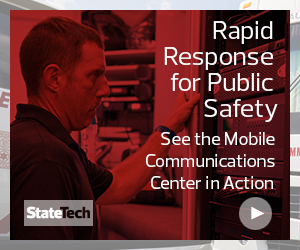What Is the State of FirstNet Today?
As hurricane season continues, first responders, especially along the Gulf of Mexico and the East Coast, are on high alert. FirstNet has them covered.
Earlier this month, AT&T announced public safety agencies subscribing to FirstNet now have access to the full fleet of 72 dedicated deployable network assets. These assets, which are stationed across the country, can either be deployed for planned events or called upon in emergencies.
The FirstNet-dedicated assets, such as Satellite Cell on Light Trucks, are mobile cellular sites that link to FirstNet via satellite and do not rely on commercial power availability, according to AT&T. They provide first responders with similar capabilities and connectivity as a cell tower.
In 2018 alone, the AT&T FirstNet team supported nearly 100 emergency and event response efforts via asset deployments and other solutions. AT&T notes these events include active shooter situations, tornadoes, wildfires and most recently, deployments for the Merrimack Valley gas explosions and Hurricane Florence.
As of the end of August, more than 2,500 public safety agencies across the country joined FirstNet, and the network supported more than 150,000 connections. As of July, Band 14 was added to more than 2,500 cell sites across the country, with the process for over 10,000 more currently underway.
AT&T is contracted to bring FirstNet to 95 percent of the U.S. population within five years, and Chris Sambar, AT&T’s senior vice president for FirstNet, said earlier this year the company is confident it can accomplish the feat within its deadline.
MORE FROM STATETECH: Find out how the New Orleans Fire Department uses data to save lives!
The Benefits of FirstNet in Disaster Response
How can FirstNet help public safety agencies? The network gives first responders an evolving set of Quality of Service, Priority and Preemption capabilities that FirstNet claims will exceed anything previously available to public safety agencies.
QPP capabilities will continue to evolve over the next several years, with the addition of mission-critical services and priority levels, according to FirstNet. “These features provide public safety users with assurance of network access whenever they need it,” according to FirstNet.
In emergencies and disasters, commercial networks quickly become congested, meaning first responders cannot communicate when they need to most. But FirstNet’s QPP service “delivers highly reliable interoperable communications for police, fire, and EMS personnel as they communicate with one another, and connect to external services and applications during both emergencies and normal daily operations,” according to FirstNet.
Further, the network provides public safety agencies with control over and visibility into the FirstNet network operational status and site conditions. “Local control is a key feature of the FirstNet solution, providing a powerful capability to optimize the user experience through a single convenient home page location,” according to FirstNet.
Security is a key element of FirstNet. The network conforms to leading industry standards of network security and operating procedures to help protect users from unauthorized access, disclosure, corruption or disruption of service.
“The FirstNet network relies on an integrated multilayer approach to threat management, firewalls, encryption, private network connections, mobile devices, and mobile application management — each helping to protect critical data, applications, and services running on the network,” FirstNet says.
FirstNet provides myriad advantages. As the network expands, public safety agencies should make sure to consider whether they want to subscribe.
This article is part of StateTech's CITizen blog series. Please join the discussion on Twitter by using the #StateLocalIT hashtag.












